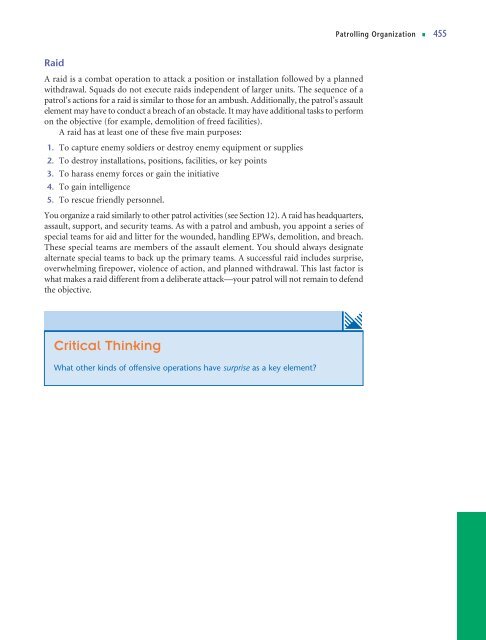Patrolling Organization.pdf - UNC Charlotte Army ROTC
Patrolling Organization.pdf - UNC Charlotte Army ROTC
Patrolling Organization.pdf - UNC Charlotte Army ROTC
- No tags were found...
Create successful ePaper yourself
Turn your PDF publications into a flip-book with our unique Google optimized e-Paper software.
<strong>Patrolling</strong> <strong>Organization</strong> • 455RaidA raid is a combat operation to attack a position or installation followed by a plannedwithdrawal. Squads do not execute raids independent of larger units. The sequence of apatrol’s actions for a raid is similar to those for an ambush. Additionally, the patrol’s assaultelement may have to conduct a breach of an obstacle. It may have additional tasks to performon the objective (for example, demolition of freed facilities).A raid has at least one of these five main purposes:1. To capture enemy soldiers or destroy enemy equipment or supplies2. To destroy installations, positions, facilities, or key points3. To harass enemy forces or gain the initiative4. To gain intelligence5. To rescue friendly personnel.You organize a raid similarly to other patrol activities (see Section 12). A raid has headquarters,assault, support, and security teams. As with a patrol and ambush, you appoint a series ofspecial teams for aid and litter for the wounded, handling EPWs, demolition, and breach.These special teams are members of the assault element. You should always designatealternate special teams to back up the primary teams. A successful raid includes surprise,overwhelming firepower, violence of action, and planned withdrawal. This last factor iswhat makes a raid different from a deliberate attack—your patrol will not remain to defendthe objective.Critical ThinkingeWhat other kinds of offensive operations have surprise as a key element?
















